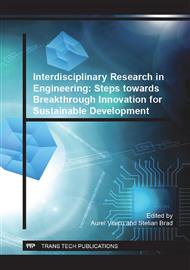[1]
V. Karthik, R.J. Comstock, D.L. Hershberger, R.H. Wagoner, Variability of sheet formability and formability testing, J. Mat. Process Tech. 121 (2002) 350-362.
DOI: 10.1016/s0924-0136(01)01219-5
Google Scholar
[2]
L. Paraianu, I. Bichis, D. Banabic, Variability analysis of the mechanical parameters in order to determine the forming limit band, AIP Conf. Proc. 1353 (2011) 1511-1516.
DOI: 10.1063/1.3589731
Google Scholar
[3]
D. Banabic, M. Vos, Modelling of the forming limit band - a new method to increase the robustness in the simulation of sheet metal forming processes, Annals of CIRP. 56 (2007) 249-252.
DOI: 10.1016/j.cirp.2007.05.058
Google Scholar
[4]
L. Paraianu, D.S. Comsa, D. Banabic, Sensitivity analysis of the mechanical parameters of the sheet metals influencing the forming limit curves, in: 3rd Int. Conf. Eng. Optim., Rio de Janeiro (2012).
Google Scholar
[5]
T. de Souza, B. Rolfe, Multivariate modelling of variability in sheet metal forming, J. Mat. Process. Tech. 203 Issues 1–3 (2008) 1-12.
DOI: 10.1016/j.jmatprotec.2007.09.075
Google Scholar
[6]
L. Marretta, R. Di Lorenzo, Influence of material properties variability on springback and thinning in sheet stamping processes: a stochastic analysis, Int. J. Adv. Manuf. Technol. 51 (2010) 117–134.
DOI: 10.1007/s00170-010-2624-4
Google Scholar
[7]
P. Sugar, J. Sugarova, L. Morovič, P. Zemko, Analysis of dimensional accuracy of spun parts by Taguchi approach, Applied Mechanics and Materials. 217-219 (2012) 2423-2426.
DOI: 10.4028/www.scientific.net/amm.217-219.2423
Google Scholar
[8]
V. Gödel, C. Annen, M. Merklein, Material modelling for stochastic simulation, in: R. Kolleck (Ed. ), Proc. 50th Conference of IDDRG 2010 Graz. Verlag der Technischen Universität Graz. (2010) 687-696.
Google Scholar
[9]
E. Atzema, M. Abspoel, P. Kömmelt, M. Lambriks, Towards robust simulations in sheet metal forming, International Journal of Material Forming. 2 (2009) 351-354.
DOI: 10.1007/s12289-009-0534-5
Google Scholar
[10]
D. Banabic, Sheet Metal Forming Processes: Constitutive Modelling and Numerical Simulation, D. Banabic (Ed. ), Springer, Berlin-Heidelberg, (2010).
DOI: 10.1007/978-3-540-88113-1_4
Google Scholar
[11]
L. Lăzărescu, I. Nicodim, I. Ciobanu, D. S. Comşa, D. Banabic, Determination of material parameters of sheet metals using the hydraulic bulge test, Acta Metallurgica Slovaca, Vol. 19, No. 1, (2013) 4-12.
DOI: 10.12776/ams.v19i1.81
Google Scholar
[12]
ARAMIS V6. 1. 1-7 User Manual Software, GOM GmbH, Braunschweig (2009).
Google Scholar
[13]
D. Banabic, D. S. Comşa, M. Sester, M. Selig, W. Kubli, K. Mattiasson, M. Sigvant, Influence of constitutive equations on the accuracy of prediction in sheet metal forming simulation, in: P. Hora (Ed. ), Numisheet 2008, Interlaken (2008) 37–42.
Google Scholar
[14]
D. Banabic, M. Sester, Influence of Material Models on the Accuracy of the Sheet Forming Simulation, Mater. Manuf. Process. 27 (2012) 304–308.
Google Scholar
[15]
AutoForm 4. 4 Software Manual, AutoForm Engineering GmbH, Zurich (2010).
Google Scholar


